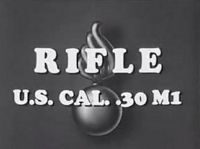A number of members wrote to us asked if we could help them view the video below, which forms part of the Knowledge Libraryentry titled Rifle Marksmanship with the M1 Garand Rifle (1942) (click here).
We've now converted it to a format which will play better on slower computers, or computers connecting to the Internet over slower network links.
Mouse Click on the film strip thumbnail.NOTE: To view most videos available on this web site, you must have Apple Quicktime (click here) or Adobe Flash Player (click here) installed on your computer, both of which are FREE. If the video doesn't play, then click on the links provided to ensure you have these standard players installed on your computer. Simply click on any film strip thumbnail pic and then if the video doesn't start immediately, press the PLAY button on the controls bar at the bottom, or it may sometimes appear in the center of the screen. Depending upon the player, some optional controls may also be available. If so, use the PAUSE and other buttons at the bottom of the video window to adjust your personal viewing preferences, or click on the video itself to stop and start playback. Make sure you turn on your speakers and set the volume appropriately.
This old training film, along with the other two hours of period training material contained in the Knowledge Library entry mentioned above, are excellent and really enjoyable to watch to get a sense of the times in which they were filmed.U.S. CAL. .30 M1 Rifle (1943)
(Principles of Operation)
This is a 1943 official training Film of the U.S. War Department displaying the principles of operation of the U.S. CAL. .30 M1 Rifle better known throughout WW2 as the “Garand”. Signal Corps ordnance experts demonstrate the intricacy of the firing mechanism behind the most expensive and one of the best rifles of the Second World War.
U.S. CAL. .30 M1 Rifle (1943)
(WWII U.S. Training Film)
Video length = 15 minutes
Enjoy ...
Regards,
BadgerInformation

Warning: This is a relatively older thread
This discussion is older than 360 days. Some information contained in it may no longer be current.
- Knowledge Library

- MKL Entry of the Month
- Australia
- Austro-Hungarian Empire
- Canada
- Czechoslovakia
- Denmark
- Finland
- France/Belgium
- Germany
- Italy
- Japan
- Norway
- Russia
- South America
- Sweden
- Switzerland
- Turkey
- United Kingdom
- United States
- Yugoslavia
- Is my rifle authentic or a fake?
- Jay Currah's Lee Enfield Web Site
- On-line Service Records (Canada)
- Technical Articles/Research
- Forum
- Classifieds

- What's New?
-
Photo Gallery

- Photo Gallery Options
- Photo Gallery Home
- Search Photo Gallery List
-
Photo Gallery Search
- Video Club

- iTrader















 PM
PM
